Visual Quickstart Guide WordPress
Second Edition
Jessica Neuman Beck Matt Beck

Visual QuickStart Guide
WordPress, Second Edition
Jessica Neuman Beck and Matt Beck
Peachpit
1249 Eighth Street
Berkeley, CA 94710
510/524-2178
510/524-2221 (fax)
Find us on the Web at www.peachpit.com
To report errors, please send a note to
Peachpit is a division of Pearson Education
Copyright 2012 by CouldBe Studios
Associate Editor: Valerie Witte
Production Editor: Becky Winter
Copyeditor: Liz Welch
Proofreader: Amy Jean Petersen
Composition: Danielle Foster
Indexer: James Minkin
Cover Design: RHDG / Riezebos Holzbaur Design Group, Peachpit Press
Interior Design: Peachpit Press Logo Design: MINE www.minesf.com
Notice of Rights
All rights reserved. No part of this book may be reproduced or transmitted in any form by any means, electronic, mechanical, photocopying, recording, or otherwise, without the prior written permission of the publisher. For information on getting permission for reprints and excerpts, contact .
Notice of Liability
The information in this book is distributed on an As Is basis, without warranty. While every precaution has been taken in the preparation of the book, neither the authors nor Peachpit shall have any liability to any person or entity with respect to any loss or damage caused or alleged to be caused directly or indirectly by the instructions contained in this book or by the computer software and hardware products described in it.
Trademarks
Visual QuickStart Guide is a registered trademark of Peachpit Press, a division of Pearson Education.
Many of the designations used by manufacturers and sellers to distinguish their products are claimed as trademarks. Where those designations appear in this book, and Peachpit was aware of a trademark claim, the designations appear as requested by the owner of the trademark. All other product names and services identified throughout this book are used in editorial fashion only and for the benefit of such companies with no intention of infringement of the trademark. No such use, or the use of any trade name, is intended to convey endorsement or other affiliation with this book.
ISBN-13: 978-0-321-79266-2
ISBN10: 0-321-79266-1
9 8 7 6 5 4 3 2 1
Printed and bound in the United States of America
Special Thanks to:
Jessica and Matt would like to thank the editorial staff at Peachpit and the Portland WordPress community, without which this book would not have been possible.
Thanks, guys!
Introduction
WordPress is an open source blogging platform that boasts the largest user base of any self-hosted blogging tool in the world. Users can set up a blog on WordPress.com or install WordPress with a hosting company or on a personal server, allowing for flexibility and easy customization. Its highly extensible, with a veritable treasure trove of add-ons and plug-ins available both in the official WordPress repository and elsewhere on the Internet. Since the project is open source, its easy for developers to work withand its free!
In this introduction, well talk about what a blog is and how to use it. Well tell you a little more about WordPress and give you an overview of new WordPress features. Well also explore the differences between WordPress.org and WordPress.com to help you decide which one is right for you.
In this book, well focus on the self-hosted version of WordPress available at WordPress.org. However, many of the usage tutorials are applicable to both self-hosted WordPress installations and WordPress.com blogs, so if youre new to WordPress, read on!
Blogs Explained
A blog is a Web site that displays posts or articles in a sequential order, with the newest posts appearing first. The word blog comes from Weblog, itself a contraction of Web and log.
Blogs began as online journals, usually featuring a single author writing about a specific topic or interest. However, blogs have expanded to encompass news sites, magazine-style sites, and even corporate Web sites, in addition to personal journals.
Blogs often fill a niche, focusing on a particular subject, and often encourage participation by enabling comments on articles or posts.
Many sites are built on blogging platforms like WordPress because the interface for adding posts and pages is easy for nontechnical users to master.
The blog format tends toward the following:
A new page is automatically generated for each post.
Each post is defined by one or more categories.
Posts can be further categorized by tags.
Posts can be read sequentially or browsed in archives by date, category, or tag.
Design and layout are dictated by a predefined template or theme; changes to the theme affect the look and feel of the site but do not affect content (making it easy to modify a sites look).
Anatomy of a WordPress Blog
Although blogs can vary widely in layout, most contain these six basic segments. Were using the default WordPress theme as an example of a typical blog layout  .
.
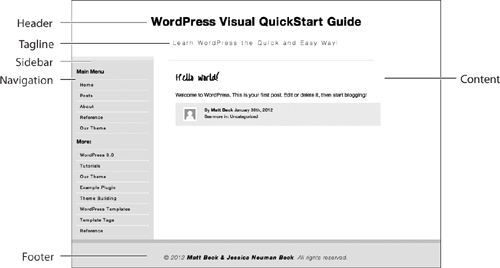
 A typical WordPress blog layout, with a header, tagline, navigation, sidebar, content, and footer.
A typical WordPress blog layout, with a header, tagline, navigation, sidebar, content, and footer.
Header: This section usually includes the blogs name and a graphic, such as a logo.
Tagline (optional): The tagline or slogan often gives the reader a better idea of what the blog is about. The WordPress default is Just another WordPress weblog.
Navigation: This consists of internal links to the different sections of the site, such as Archives, About, and Home.
Content: This section changes depending on what section of the blog is being viewed; for example, on the home page the content may be an overview of the latest posts, whereas the contact page would include information and perhaps a form for getting in touch with the blogs author.
Sidebar: Additional navigation may be located here, as well as snippets of code known as widgets, which may contain information such as the authors latest Twitter posts, polls, an overview of recent comments, or photos recently posted to Flickr.
Footer: This section usually contains copyright and design information.
In addition, each posts page contains information specific to the post, such as the time and date of posting, the author, the categories and/or tags, and (if comments are enabled) a place for readers to contribute their thoughts.
Whats New in This Edition
WordPress regularly releases updates to their core platform, debuting new features, security fixes, and stability increases in controlled bursts. After WordPress 2.1, the development team began releasing updates on a regular schedule, roughly every 3 to 4 months. Major updates are named after famous jazz singers.
WordPress 3.0 (named after Thelonious Monk) saw a major overhaul of the WordPress platform, merging WordPress MU (Multi-User) with the WordPress core and making it possible to manage multiple installations of WordPress from one main installation. It also included many new features, such as the following:


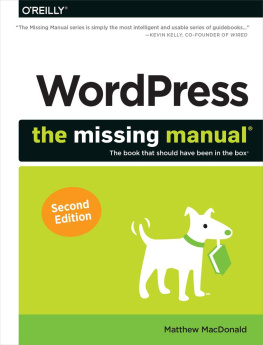



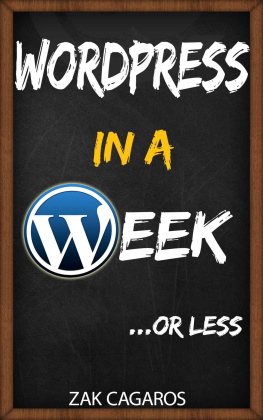
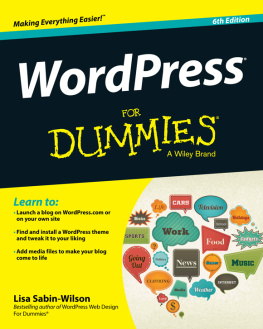
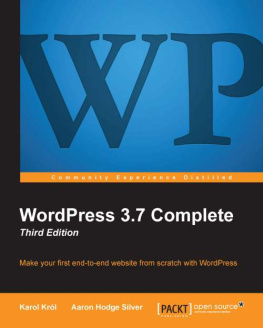


 .
.